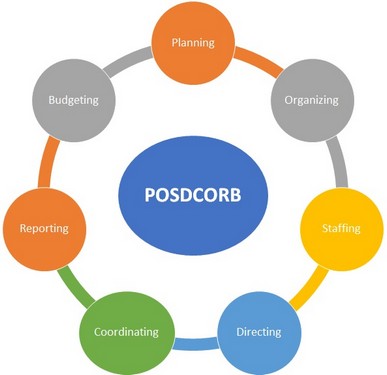- Business Concepts ›
- Marketing and Strategy ›
- POSDCORB
POSDCORB
Definition, Importance, Steps & Example
This article covers meaning & overview of POSDCORB from marketing perspective.
What is meant by POSDCORB?
POSDCORB is an acronym which means Planning, Organizing, Staffing, Directing, Coordinating, Reporting and Budgeting which was first coined in a paper on administrative management that was written for the Brownlow Committee by Luther Gulick and Lyndall Urwick. POSDCORB can be used as a systematic framework for efficiently executing business processes in a company or by an individual. It is just not a buzzword but a complete structured foundation for organizational transparency and perfection. POSDCORB with its 7 foundational pillars simplifies complex business and public sector issues.
POSDCORB Steps
As we have already understood that POSDCORB is a series of steps for management, we need to understand these steps.
These are various steps or stages involved in a typical administrative process. POSDCORB can be explained sequentially in detail below:
1.Planning
This essentially refers to establishing a broad sketch of the work to be completed and the procedures incorporated to implement them.
Planning is the first and most important step in POSDCORB as it sets the overall structure of the process with activities and timelines.
2.Organizing
Organizing involves formally classifying, defining and synchronizing the various sub-processes or subdivisions of the work to be done.
It makes sure that the activities and timelines in the first step of planning are refined and organized further so that right people can be staffed to execute these tasks.
3.Staffing
This involves recruiting and selecting the right candidates for the job and facilitating their orientation and training while maintaining a favorable work environment.
4.Directing
This entails decision making and delegating structured instructions and orders to execute them.
Directing is an important step in the POSDCORB cycle as it makes thing happen by giving clear objectives to teams and individuals.
5.Coordinating
This basically refers to orchestrating and interlinking the various components of the work.
6.Reporting
Reporting involves regularly updating the superior about the progress or the work related activities. The information dissemination can be through records or inspection.
7.Budgeting
Budgeting involves all the activities that under Auditing, Accounting, Fiscal Planning and Control.

The above image shows the various stages of POSDCORB
Importance of POSDCORB
Every business needs to have systematic framework in ensuring there is maximum output, minimum wastage and higher margins. POSDCORB is one such method in management where workforce and employees can be managed in a way which would be beneficial for a company.
This concept helps organizations to break down the work into multiple processes and help in getting maximum value out to each employee. These steps and stages of POSDCORB help the HR team to deliver to the needs of a company.
Example of POSDCORB
Consider a multinational starting an exercise involving a good number of employees in the workforce. As per POSDCORB, the planning stage would be doing the thorough research about the number of people needed, team size, work type etc. Organizing and staffing stages would be the HR department making a list of people i.e. supervisors and subordinates who would could execute this role.
Once this is done, as per POSDCORB directing would be giving instructions and ensuring implementation of the plan as per the requirement. To ensure a better two way communication, coordinating plays a pivotal role. Once all this done, the different ways of reporting are done which ensures accountability and responsibility of the team.
Finally, the budget to be allocated is studied. In this way, POSDCORB can be used for better management.
Hence, this concludes the definition of POSDCORB along with its overview.
This article has been researched & authored by the Business Concepts Team which comprises of MBA students, management professionals, and industry experts. It has been reviewed & published by the MBA Skool Team. The content on MBA Skool has been created for educational & academic purpose only.
Browse the definition and meaning of more similar terms. The Management Dictionary covers over 1800 business concepts from 5 categories.
Continue Reading:
What is MBA Skool?About Us
MBA Skool is a Knowledge Resource for Management Students, Aspirants & Professionals.
Business Courses
Quizzes & Skills
Quizzes test your expertise in business and Skill tests evaluate your management traits
Related Content
All Business Sections
Write for Us